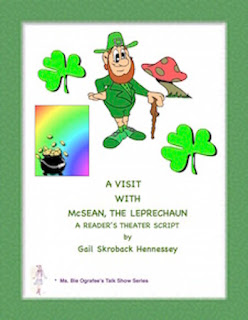APRIL FOOLS’ DAY!
April Fools’ Day is coming. I remember when I was young eager to tell my father that his shoes were untied so he’d look down and I could say,”April Fools' Day”.
I remember kids calling the local zoo and asking for Mr. Peacock(or other resident of the zoo). Whispering to someone that they had a rip in their pants was also a popular thing to say to someone. Gluing a coin to the floor and seeing someone bend down to pick it up was another prank done on April Fools' Day.
April Fools’ Day is an opportunity to show kids that history is all around us, even holidays such as April Fools’ Day have a history! April Fools' Day is a great opportunity to discuss and identify FAKE NEWS. It is also a great opportunity to discuss bullying and the difference of doing silly pranks as opposed to mean-spirited or hurtful ones. It’s a day I encouraged students to do an act of kindness for someone else.
READ ABOUT THE HISTORY OF APRIL FOOLS’ DAY
All Fools’ Day as April 1st was once called, is a custom that came to the American colonies from the French and British. Although the actually start of April Fools’ Day is not certain, many say the day of doing pranks dates back to the 16th century France. At this time, the new year was celebrated on April 1st and not January 1st. When a new calendar, called the Gregorian Calendar, was introduced, the new year fell on January 1st. Without television, radio, internet, etc., and with many people not being able to read, some people didn’t get the news of the new day for ringing in the new year for a couple of years! Other people just refused to change their celebration day for the new year. These people became the joke of others for whom tricks were played. Things done included sending these people on foolish errands, or to try and tell them things which weren’t true.
The idea of April Fools’ Day soon spread to other countries. In England, pranks are only done in the morning and it’s considered bad luck to attempt an April Fools’ trick on someone after noon time. And, if you are the victim of someone’s joke, you are called a noodle! In India, in addition to pranks, people put colors on each other to celebrate the start of spring. If you go to the country of Portugal, watch for flying flour, which is what people like to throw on April Fools’ Day! In France, people call each other Poisson d’Avril which means April Fish instead of April Fools! Why a fish? That’s because a young fish is thought to be easily caught, not knowing better. A common activity on this day in France is to put a paper fish on someone’s back.
Some famous April Fools’ Day Pranks:
1. A famous April Fools’ Day activity occurred in 1998 when Burger King said they had a new “left-handed Whopper” which had the ketchup, pickles and other condiments on the left side of the bun to help left handed eaters. Many came in to order “left” Whoppers on that day!
2. In 1957, a news show aired a video on a spaghetti harvest in the country of Switzerland. People were pulling strands of spaghetti dangling down from trees. People actually called the news show asking how they could purchase a spaghetti tree!
3. In 1996 the Taco Bell Company said they had bought the famous Liberty Bell and were renaming it the Taco Liberty Bell! Many people called the National Historic Park in Philadelphia, PA, saying they were angry about the sale of the Liberty Bell to a food restaurant!
I have an April Fools' Day resource. In addition to the reading passage on the history of the holiday, there are 15 famous April Fools’ Day pranks. There is also an activity with 8 “What do You Think?(Prank or True). For example: Scientists are working on Smell-O-Vision, televisions that can produce thousands of smells so, for example, if you are watching a cooking show, you may be able to smell the onions!(answer: Once done as a hoax back in 1965, some scientists are currently experimenting with this idea…so true)
There are also 8 comprehension questions and 7 extended activities. Click here:
PS: I have seen April Fool's Day and April Fools' Day. Reference books say that April Fools' Day is more correct.
Use this time to start a discussion on FAKE NEWS: This resource works well with my April Fool's Day Resource: https://www.teacherspayteachers.com/Product/FAKE-NEWS-Developing-Digital-Critical-Literacy-with-Kids-INA-3074653
More April Fools' Pranks to Share:
Click here for FREE download: https://www.teacherspayteachers.com/Product/APRIL-FOOLS-FREEBIEReally-2474186
1. The oldest recorded April Fools’ Day prank may date back to 1698! People in London, England, were told that lions would be washed in the moat(ditch) around the Tower of London. Several people went to see the washing of the lion. Arriving at the Tower of London, there were no lions to be seen in the moat getting lathered up with soap. The date of the event: April 1st!
2. Thomas Edison was featured in an April Fools’ Day prank dating back to 1878. The New York Graphic Newspaper announced on its front page that the famed inventor had developed a machine that could take soil and change it into cereal and vegetables. It could also turn water into wine and produce biscuits. No one would ever need to go hungry again. Newspapers around the country announced the invention giving Edison much praise. The invention would change the world! The date of the article said it all…April 1st.
3. People lined the banks of the Arkansas River. in 1906, after the Wichita Daily Eagle’s front page told of a massive wave(11 ft. high) carrying millions of frogs would get to the city of Wichita at exactly 10AM. Said to be 11 miles in length, people waited for hours for the amazing occurrence only to realize that it was an April Fools’ Day prank.
4. In 1974, people living in Sitka, Alaska, were frightened when billows of black smoke rose from Mount Edgecumbe, a dormant volcano. Could the volcano be erupting?Turns out that someone had brought old tires into the crater and set them on fire as an April Fools’ Day prank.
5. In 2013, people were amazed to hear that Virgin was introducing a glass-bottom airplane! Imagine, sitting in an airplane and SEEING the clouds beneath your feet. Many people were very excited about this new airplane and took to social media to spread the word. It was an April Fools’ Day prank.
1. Illustrate one of the famous pranks.
2. Write a fake news story
3. Think of an act of kindness you can do.
4. Write 2 facts about the countries of France, England, India and Portugal
Illustrations from: wpclipart.com


















